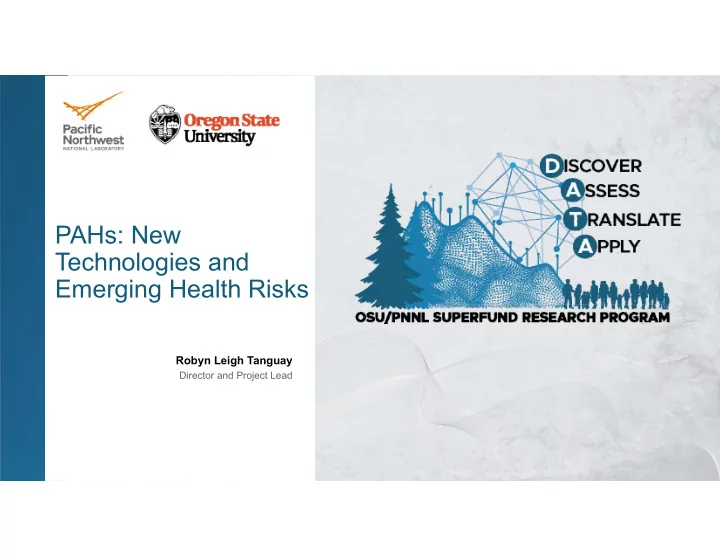

PAHs: New Technologies and Emerging Health Risks Robyn Leigh Tanguay Director and Project Lead
The Problem • Approximately 53 million people live within 3 miles of a Superfund site. • PAHs are 3 of the top 10 ATSR Priority List of Hazardous Substances • More than 100 parent PAH compounds • Unknown number of PAH derivatives and metabolites • Parent PAHs arise from industrial processes and from extraction and burning of fossil fuels • PAHs typically exist in complex environmental mixtures • Substantially higher concentrations of PAHs in the soil, and water 2
PAH Health Effects • Human exposure - primarily via ingestion • A subset of PAHs are known carcinogens • The majority of available research in on the US EPA 16 priority PAHs • Mounting evidence other PAHs are a concern • Non-cancer affects 3
Toxicity Mechanisms for Most PAHs Unknown Environmentally dynamic Parent, substituted compounds Toxicity data was scarce for substituted PAHs PAHs induce AHR-dependent and AHR-independent developmental toxicity, dependent on structure We lack the structural basis to predict toxicity 4
Overall Mission Identify polycyclic aromatic hydrocarbons (PAHs) in the environment, to characterize their toxicity, and to specify the levels of those chemicals in the environment below which they pose no threat to human health. We will supply EPA and other partners with actionable information and with tools that enable them to detect PAHs in the environment, to measure PAH concentrations, and to evaluate remediation. 5
Overall Center Aims • Collect PAH mixtures at Superfund sites and assess their toxicity • Predict and identify new PAH compounds created as a byproduct of remediation at Superfund sites and assess their toxicity. • Deploy passive sampling technology in a wearable format to assess human PAH exposures. • Identify gene expression networks targeted by PAH exposure that can serve as early indications of disease. • Determine how exposure susceptibility across test systems and humans depends upon PAH physicochemical properties, tissue and body composition. 6
7
Center Integration 8
Predicting the Toxicity of Complex PAH Mixtures Robyn L. Tanguay
Project Aims • Determine how the developmental impacts of PAH exposure depend on the composition of PAH mixtures and the chemical structures of environmentally transformed PAHs • Measure the uptake and metabolism of biologically active PAHs • Develop diagnostic gene expression pathways for classes of PAHs, determine how those pathways vary as a function of dose • Determine adult and transgenerational consequences following transient developmental exposures to individual PAHs, real-world mixtures, and model mixtures. 10
Comparative PAH Toxicity Assessment
Assembled Library of PAHs for Comparative Analysis Kim Anderson - SRP Chemical Mixtures Core
High-Throughput PAH Assessments 24 hpf 120 hpf 6 hpf loess [uM] 0 100 0.000128 0.00064 0.0032 0.016 0.08 0.4 2 10 80 50 1e+05 60 Movement 40 20 0 21 29 32 35 36 39 42 48 Time Exposure 5 day evaluations 24 hour evaluations • Dechorionated • Morphology • Behavior • 6 hpf to 120 hpf • Behavior • Morphology • 5 concentrations • CYP1A • N=32/Concentration Localization
CYP1A Expression Pattern as an Exposure Biomarker of AHR Activation 120 hpf
127 PAH Clustered by CYP1A Expression
RNA-SEQ Analysis (Embryonic Expression) DB[a,l]P B[a]P PYR-24h BAN-24h BAN-48h PYR-48h DBT-24h DBT-48h BAP(1) BAAQ PHEQ BEZO DBC BAP 7,12-Ba[A]Q BEZO 9,10-PHEQ Designed to identify Causal Changes in DBT BAN PYR gene expression
Measuring Development Origins Of Health Diseases DOHaD Swimming activity Anxiety Aggression Social Interactions Learning
Acknowledgements Shawn Tucker, Program Manager Lisa Shepard, Finance Manager Michael Barton, Data Systems Manager Bill Suk, Director Superfund Research Program Danielle Carlin, Program Administrator P42 ES016465 18
Thank you Contact: robyn.tanguay@oregonstate.edu _ More Information: https://superfund.oregonstate.edu/ _ _ _ 19
Recommend
More recommend